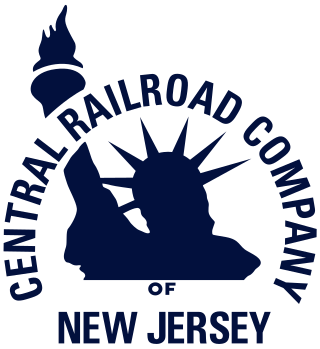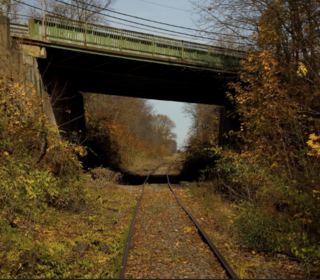The Pennsylvania Railroad, legal name The Pennsylvania Railroad Company, also known as the "Pennsy", was an American Class I railroad that was established in 1846 and headquartered in Philadelphia. It was named for the commonwealth in which it was established. At its peak in 1882, the Pennsylvania Railroad was the largest railroad, the largest transportation enterprise, and the largest corporation in the world.

The Reading Company was a Philadelphia-headquartered railroad that provided passenger and freight transport in eastern Pennsylvania and neighboring states from 1924 until its acquisition by Conrail in 1976.

The Central Railroad of New Jersey, also known as the Jersey Central, Jersey Central Lines or New Jersey Central, was a Class I railroad with origins in the 1830s. It was absorbed into Conrail in April 1976 along with several other prominent bankrupt railroads of the Northeastern United States.

Cape May Seashore Lines is a short line railroad in southern New Jersey that operates both freight trains and excursion trains. It offers two excursion services: a 30-mile (48 km) round trip between Richland and Tuckahoe along the Beesley's Point Secondary railroad line and a 14-mile (23 km) round trip between Rio Grande, Cold Spring Village, and Cape May City along the Cape May Branch. The track is owned by NJ Transit and leased to the Seashore Lines. The Cape May Branch is the original line operated by the Cape May Seashore Lines and runs from Cape May north to Tuckahoe, connecting to the Beesley's Point Secondary in Tuckahoe. Cape May Seashore Lines operates freight service along the Beesley's Point Secondary line between Winslow and Palermo, interchanging with Conrail Shared Assets Operations in Winslow. Tony Macrie has been president of the Seashore Lines since he formed the railroad in 1984.

The Atlantic City Line (ACL) is a commuter rail line operated by NJ Transit (NJT) in the United States between Philadelphia, Pennsylvania and Atlantic City, New Jersey, operating along the corridor of the White Horse Pike. It runs over trackage that was controlled by both the Pennsylvania Railroad (PRR) and the Pennsylvania-Reading Seashore Lines. It shares trackage with SEPTA and Amtrak on the Northeast Corridor (NEC) until it crosses the Delaware River on Conrails Delair Bridge into New Jersey.
Railroad electrification in the United States began at the turn of the 20th century and comprised many different systems in many different geographical areas, few of which were connected. Despite this situation, these systems shared a small number of common reasons for electrification.

Pavonia Yard is a Conrail Shared Assets Operations (CSAO) rail yard in Camden, New Jersey.

Reading Company 902 and Reading Company 903 are two preserved ex-Reading Company EMD FP7s.

The Pennsylvania Railroad's MP54 was a class of electric multiple unit railcars. The class was initially constructed as an unpowered, locomotive hauled coach for suburban operations, but were designed to be rebuilt into self-propelled units as electrification plans were realized. The first of these self-propelled cars were placed in service with the PRR subsidiary Long Island Rail Road with DC propulsion in 1908 and soon spread to the Philadelphia-based network of low frequency AC electrified suburban lines in 1915. Eventually the cars came to be used throughout the railroad's electrified network from Washington, D.C. to New York City and Harrisburg, Pennsylvania.
The West Jersey and Seashore Railroad (WJ&S) was a Pennsylvania Railroad subsidiary in the U.S. state of New Jersey with a connection to Philadelphia. It was formed through the merger of several smaller roads in May 1896. At the end of 1925 it operated 379 miles (610 km) of road on 717 miles (1,154 km) of track; that year it reported 166 million ton-miles of revenue freight and 332 million passenger-miles. The railroad became part of Pennsylvania-Reading Seashore Lines in 1933.
The Atlantic City Railroad was a Philadelphia and Reading Railway subsidiary that became part of Pennsylvania-Reading Seashore Lines in 1933. At the end of 1925, it operated 161 miles (259 km) of road on 318 miles (512 km) of track; that year it reported 43 million ton-miles of revenue freight and 204 million passenger-miles.
Pennsylvania Railroad's E1 class comprised three experimental Atlantic 4-4-2 locomotives built in 1899 to compete with the Reading Railroad on the Philadelphia, Pennsylvania, to Atlantic City, New Jersey, high-speed seashore passenger train service. These engines were designed as cab-center or camelback locomotives with wide fireboxes and 80" drivers that carried 50,000 lbs per axle. They proved capable in fast service but the inherent danger of separating the engineer from the fireman was unacceptable to the PRR so they were sold to their subsidiary the Long Island Rail Road in 1903. While the camelback design was unfavorable the Atlantic style proved to be everything the Pennsylvania Railroad needed at that time. They went on to acquire 596 additional units over the next fifteen years.

Penns Grove Secondary is a rail freight line in the Delaware Valley in the southwestern part of New Jersey. Part of Conrail's South Jersey/Philadelphia Shared Assets it runs for approximately 20 miles (32 km) between its it southern terminus at Penns Grove and Woodbury at the north where it joins the Vineland Secondary about 8.5 miles (13.7 km) south of Pavonia Yard in Camden. At its southern end the Deepwater Point Running Track continues another 3.7 miles (6 km) through Carneys Point to Deepwater.
The Vineland Secondary is a rail line owned, operated and maintained by Conrail Shared Assets Operations for the use of CSX Transportation and Norfolk Southern Railway. It begins at Pavonia Yard in Camden and heads south, with a spur serving the Port of Camden. At Woodbury it junctions with the Salem Branch and Penns Grove Secondary, and continues to Millville, passing through namesake Vineland. At its southern end it connects to the OmniTRAX-owned Winchester and Western Railroad. The line is used exclusively for freight, however, the northern portion is planned to be used for the proposed Glassboro–Camden light rail line.

The Salem Branch is a rail freight line in the southwestern part of New Jersey in the United States between the Port of Salem and Woodbury Junction where it and the Penns Grove Secondary converge with the Vineland Secondary, approximately 8.5 miles (13.7 km) south of Pavonia Yard in Camden.

The Cape May City Rail Terminal is a passenger train station in Cape May, New Jersey. The station offered train service from 1863 through 1981.

Woodbury is a defunct commuter railroad station in the city of Woodbury, Gloucester County, New Jersey. Located at the junction of Station Road and Cooper Street, the station served multiple lines of the Pennsylvania-Reading Seashore Lines and the Pennsylvania Railroad. Trains out of Woodbury serviced lines to Salem, Millville, Penns Grove/Carneys Point and Cape May. Woodbury station consisted of two side platforms and a 72-by-20-foot brick station depot.

Glassboro is an inactive train station in Glassboro, New Jersey which served passengers from 1863–1971. Its station house was restored c. 2015. It is located at the edge of the Rowan University campus. Listed as the West Jersey Rail Road Glassboro Depot, it was added to the National Register of Historic Places on April 14, 2020, for its significance in architecture and transportation.

Atlantic City Union Station was an intercity passenger rail station located at 2121-2125 Arctic Avenue in Atlantic City, New Jersey. It was opened in 1934 by the Pennsylvania-Reading Seashore Lines (PRSL) and consolidated the operations of the two previously competing rail lines. In 1964, construction of the Atlantic City Expressway severed the rail connection to the station. It was then renovated and became the Atlantic City Municipal Bus Terminal while rail service was relocated north to a more modest building on Bacharach Boulevard. It served as a bus terminal until 1997 when it was demolished. The former station site is now occupied by a retail outlet mall.





















